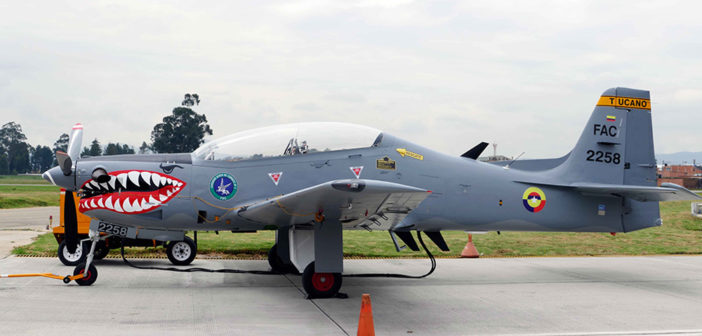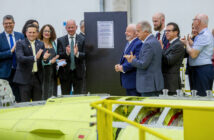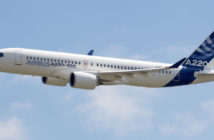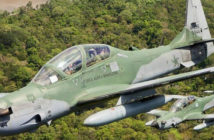Madrid, Colombia, 30 September 2017 — With over 660 aircraft produced between 1980 and 1996 (504 by Embraer and 160 by Short Brothers), the EMB-312 or T-27 Tucano is certainly one of the most successful Brazilian military aerospace programmes and one that has contributed to make Embraer famous on the international market. A total of fifteen different air forces, besides the Força Aérea Brasileira (FAB), selected and fielded this turboprop-powered two-seat trainer, many of them still flying very actively this dependable aircraft after two decades and more.
Designed by Embraer’s leading engineer Guido Pessotti in 1978 after a Brazilian Air Force detailed request and built around a 552 kW (750 hp) Pratt & Whitney Canada PT6A-25C turbine, fitted with Martin-Baker ejection seats, the Tucano was the first turboprop trainer developed from the beginning as a lead-in aircraft for transition to jets. Precisely to replace the Cessna T-37 twin-jet trainer which the USAF, under massive US aid to South American nations, supplied to Brazil during the Cold War. Major features include an automatic torque control system and a jet-like single-lever throttle which combined both engine power and propeller pitch, assuring smooth and rapid acceleration and deceleration making the Tucano an adequate lead-in trainer. High manoeuvrability, stability at low speeds, and four underwing pylons providing for up to 1,000 kg (2,200 lb) of ordnance (including machin-gun pods), allows the Tucano to engage in CAS for low-intensity conflict or counterinsurgency environments. The type can carry up to 694 litres (183 US gal) of fuel internally; additionally, two fuel tanks of 660 litres (170 US gal) can be fitted to underwing weapon stations for extended endurance enabling up to nine flight hours. To keep the Tucano price under $ 1 million a piece, the aircraft was fitted with many « off the shelf » items like its landing gear which is that of the Piper Navajo, and aircraft already produced under license in Beazil by Embraer as the EMB-820C Carajá.
After the type as chosen by the Fuerza Aérea Colombiana (FAC) in 1991, fourteen AT-27s were ordered in 1992, with delivery of the first thirteen units taking place late during the same year. Followed by the last aircraft in early 1993 ¬— just before the first of 50 Tucanos started being delivered to the French Air Force. Assigned to Grupo de combate Nº 21 (CACOM 2) in Apiay, in Meta province, the fourteen aircraft were initially devoted to advanced training, although the type was soon assigned to perform close air support missions along the FAC’s OV-10 Broncos, now retired. This as part of counter-insurgency all-round operations during the long-standing war against the Colombian rebellion mostly led by the FARC and ELN.
Nearly 90,000 flight hours have been completed since the type’s introduction in Colombia, without a single loss, and the whole fleet is now undergoing a thorough modernization programme performed by CIAC at the FAC’s Madrid air base “Mayor Justino Mariño Cuesto”, located some 25 km north-west of Bogota, home of CAMAN or Comando Aéreo de Mantenimiento, the main overhaul complex of the Colombian Air Force, and the first air base organized by the FAC in the vicinity of Bogota back in 1927 with French military assistance.
As of the beginning of this decade, after two decades of service, the lasting civil war scenario led the Fuerza Aérea Colombiana to push the type beyond its designed horizon to overcome its operational limits even if no less than twenty-five A-29 Super Tucano were purchased and delivered between 2006 and 2008.
In 2011, as part of the Brazilian national Strategic Development Plan (Plano Estratégico Institucional 2011–2030) aimed at enhancing the Brazilian Air Force Tucano fleet (numbering at that time some 110 aircraft still active in various roles), Embraer marketed a modernization plan for all the operators of the type. Response was weak, and only Colombia showed a keen interest. Then began in 2014 a three-year programme to uprate the Colombian T-27 fleet directly in Colombia under the supervision of CIAC (Corporación de la Industria Aeronáutica Colombiana SA), one of the rare South American organization ISO 9001-accredited. Designed to extend the type’s lifespan by 15 years, the structural retrofit program involves fitting the airframe with new and strengthened wings and a stronger landing gear to leverage the weight increase. An « hi-tech » avionics suite is added, provided by Rockwell Collins (INS/GPS and ACARS) and by Cobham for the “glass cockpit” made off two large multi-function electronic displays. The first prototype was finalized and produced by Embraer in Brazil, while the thirteenth subsequent Tucanos are under the responsibility of CIAC. So far a total of eleven Tucanos have been « zero-houred » and fully modernized, with exactly ten aircraft passed over to CACOM 2’s Grupo de Combate 21 in Apiay in Meta province which is the main operator of the T-27 in the Fuerza Aérea Colombiana.
CACOM 2 — which is now approaching 90 000 h of flight on T-27 Tucano without accident — made the front page of the Colombian press in March 2008, during operation Fénix, attacking at night with bombs and rockets — at just a few kilometers inside Ecuador, in Santa Rosa de Sucumbíos across Colombia’s southern border — a Colombian terrorist camp where Raúl Reyes, the deputy commander of the FARC terrorist group was killed along with two dozen narco-communist rebels. The French government in particular, anxious at that time to secure the freedom of Franco-Colombian politician Ingrid Betancourt, kidnapped in 2002, lamented Reyes’ passing — something of an irony, perhaps, since it was Reyes’ idea to kidnap politicians and hold them to ransom for political gain!
With the now proven industrial close collaboration of Embraer in the Tucano renovation programme, CIAC hopes to be able to offer in the months and years to come a complete similar Tucano modernization plan to other Latin American air forces using its gaine expertise. Honduras and Peru have already expressed interest, as has Paraguay. //




